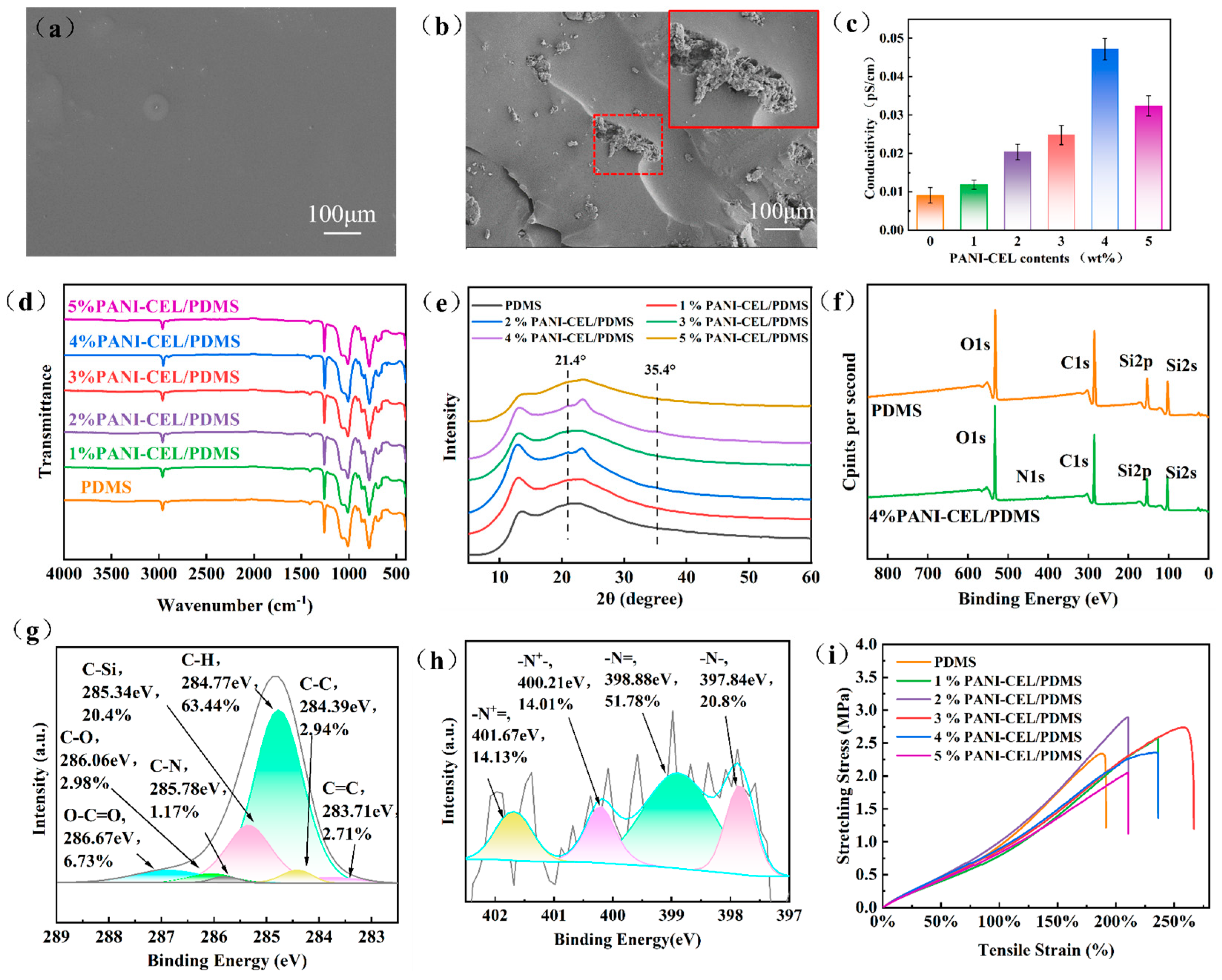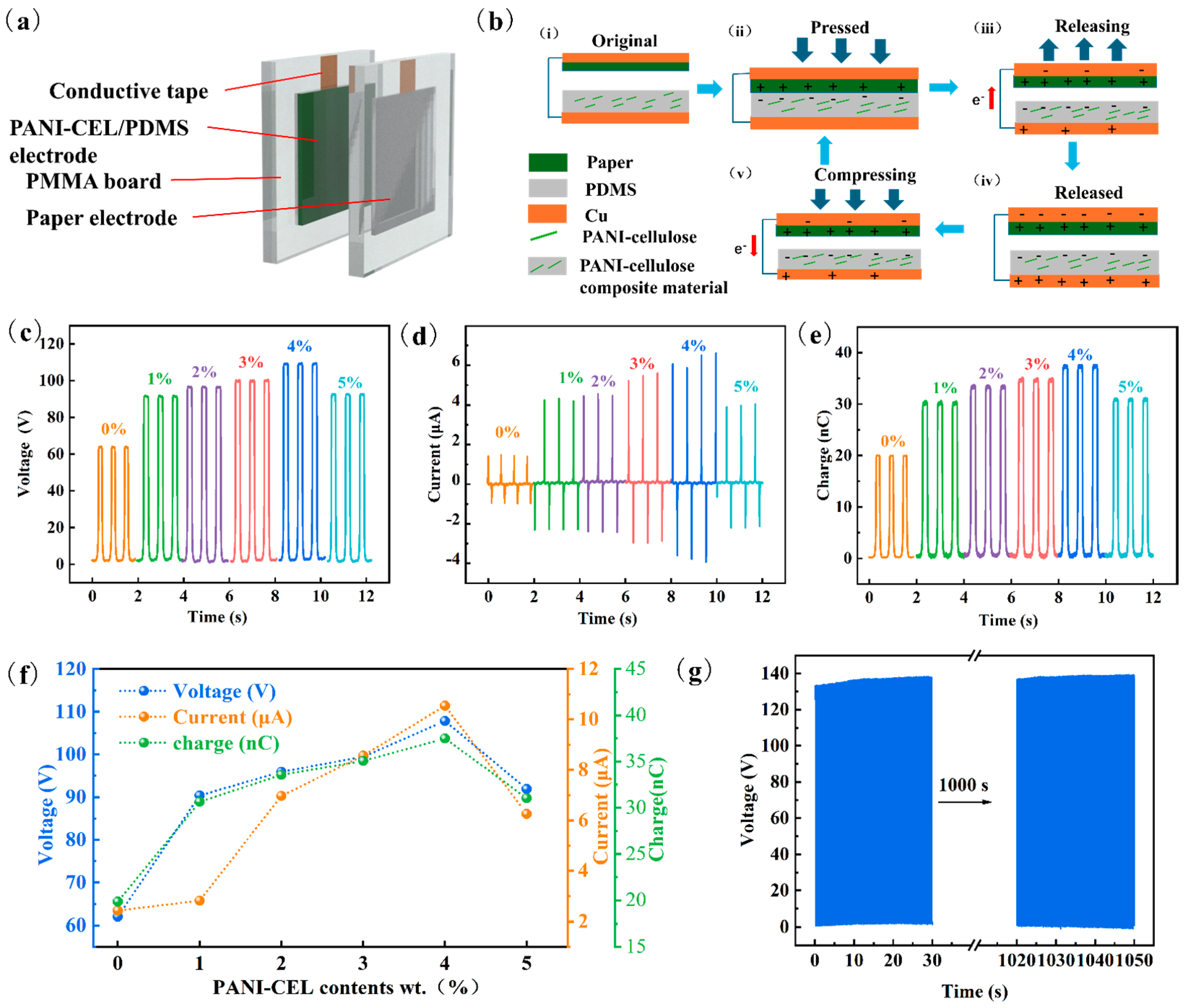Preparation of Polyaniline-Modified Cellulose/PDMS Composite Triboelectric Material and Application of Its Pretreatment in MOW Pulp
Abstract
:1. Introduction
2. Materials and Methods
2.1. Materials
2.2. Preparation of PANI-Modified Cellulose
2.3. Preparation of PDMS Composites
2.4. Preparation of Tubular TENG
2.5. TENG’s Handling of MOW
2.6. Measurement and Characterization
3. Results and Discussion
3.1. Design Principle of PANI-Modified Cellulose/PDMS Triboelectric Material and Tubular TENG
3.2. Structural Characteristics of Composite Materials
3.2.1. PANI Surface Morphology and Structural Characterization of Cellulose before and after PANI Modification
3.2.2. Characterization of Surface Morphology and Structure of PDMS Composites
3.3. Triboelectric Properties of PDMS Composites
3.4. PDMS Composite Pipeline Electrical Output
3.5. Application of G-TENG Self-Powered Pretreatment in MOW Pulp
4. Conclusions
Author Contributions
Funding
Institutional Review Board Statement
Data Availability Statement
Acknowledgments
Conflicts of Interest
References
- Perera, F.; Nadeau, K. Climate Change, Fossil-Fuel Pollution, and Children’s Health. N. Engl. J. Med. 2022, 386, 2303–2314. [Google Scholar] [CrossRef]
- Wu, H. Trade openness, green finance and natural resources: A literature review. Resour. Policy 2022, 78, 102801. [Google Scholar] [CrossRef]
- Zhang, X.; Han, L.; Wei, H.; Tan, X.; Zhou, W.; Li, W.; Qian, Y. Linking urbanization and air quality together: A review and a perspective on the future sustainable urban development. J. Clean. Prod. 2022, 346, 130988. [Google Scholar] [CrossRef]
- Puri, M.; Gandhi, K.; Kumar, M.S. Emerging environmental contaminants: A global perspective on policies and regulations. J. Environ. Manag. 2023, 332, 117344. [Google Scholar] [CrossRef]
- Wang, T.; Zhu, Q.; Zhu, Q.; Yang, Q.; Wang, S.; Luo, L. A highly stable bimetallic organic framework for enhanced electrical performance of cellulose nanofiber-based triboelectric nanogenerators. Nanoscale Adv. 2022, 4, 4314–4320. [Google Scholar] [CrossRef]
- Jiang, D.; Lian, M.; Xu, M.; Sun, Q.; Xu, B.B.; Thabet, H.K.; El-Bahy, S.M.; Ibrahim, M.M.; Huang, M.; Guo, Z. Advances in triboelectric nanogenerator technology—Applications in self-powered sensors, Internet of things, biomedicine, and blue energy. Adv. Compos. Hybrid Mater. 2023, 6, 57. [Google Scholar] [CrossRef]
- Wang, W.; Yang, D.; Yan, X.; Wang, L.; Hu, H.; Wang, K. Triboelectric nanogenerators: The beginning of blue dream. Front. Chem. Sci. Eng. 2023, 17, 635–678. [Google Scholar] [CrossRef]
- Mi, Y.; Lu, Y.; Shi, Y.; Zhao, Z.; Wang, X.; Meng, J.; Cao, X.; Wang, N. Biodegradable Polymers in Triboelectric Nanogenerators. Polymers 2023, 15, 222. [Google Scholar] [CrossRef] [PubMed]
- Qi, L.; Wang, J.; Dai, X.; Ning, F.; Yang, P.; Chen, J.; Li, Y.; Chen, J.; Zhao, Y.; Zhang, X. Interspersed Reticulate Cu2WS4 Nanocrystal–PVDF/Ni Triboelectric Nanogenerators for Rhodamine B Degradation. ACS Appl. Nano Mater. 2023, 6, 22015–22024. [Google Scholar] [CrossRef]
- Wang, Z.; Liang, X.; Liu, Z.; Huang, T.; Wang, S.; Yao, S.; Ding, Y.; Zhang, J.; Wan, X.; Wang, Z.L.; et al. Self-powered electrochemical water treatment system for pollutant degradation and bacterial inactivation based on high-efficient Co(OH)2/Pt electrocatalyst. Nano Res. 2023, 16, 2192–2198. [Google Scholar] [CrossRef]
- Wolf, M.P.; Salieb-Beugelaar, G.B.; Hunziker, P. PDMS with designer functionalities—Properties, modifications strategies, and applications. Prog. Polym. Sci. 2018, 83, 97–134. [Google Scholar] [CrossRef]
- Qi, D.; Zhang, K.; Tian, G.; Jiang, B.; Huang, Y. Stretchable Electronics Based on PDMS Substrates. Adv. Mater. 2021, 33, 2003155. [Google Scholar] [CrossRef]
- Miranda, I.; Souza, A.; Sousa, P.; Ribeiro, J.; Castanheira, E.M.S.; Lima, R.; Minas, G. Properties and Applications of PDMS for Biomedical Engineering: A Review. Funct. Biomater. 2022, 13, 2. [Google Scholar] [CrossRef]
- Sun, Z.; Yang, W.; Chen, P.; Zhang, Y.; Wang, X.; Hu, Y. Effects of PDMS Base/Agent Ratios and Texture Sizes on the Electrical Performance of Triboelectric Nanogenerators. Adv. Mater. Interfaces 2022, 9, 2102139. [Google Scholar] [CrossRef]
- Zhu, Q.; Wang, T.; Wei, Y.; Sun, X.; Zhang, S.; Wang, X.; Luo, L. Low-cost, environmentally friendly and high-performance cellulose-based triboelectric nanogenerator for self-powered human motion monitoring. Cellulose 2022, 29, 8733–8747. [Google Scholar] [CrossRef]
- Sheng, Z.; Qiuxiao, Z.; Tingting, W.; Xuchong, W.; Xiaoping, S.; Yuhe, W.; Lianxin, L. Contact electrification property controlled by amino modification of cellulose fibers. Cellulose 2022, 29, 3195–3208. [Google Scholar] [CrossRef]
- Bulathsinghala, R.L.; Ravichandran, A.; Zhao, H.; Ding, W.; Dharmasena, R.D.I.G. The intrinsic impact of dielectric constant on output generation of triboelectric nanogenerators. Nano Energy 2024, 123, 109383. [Google Scholar] [CrossRef]
- Varghese, H.; Hakkeem, H.M.A.; Chauhan, K.; Thouti, E.; Pillai, S.; Chandran, A. A high-performance flexible triboelectric nanogenerator based on cellulose acetate nanofibers and micropatterned PDMS films as mechanical energy harvester and self-powered vibrational sensor. Nano Energy 2022, 98, 107339. [Google Scholar] [CrossRef]
- Jose, D.; Jelmy, E.J.; Subin, P.S.; Joseph, R.; John, H. Triboelectric nanogenerator based on polyaniline nanorods incorporated PDMS composites through a facile synthetic route. J. Mater. Sci. Mater. Electron. 2022, 33, 15408–15421. [Google Scholar] [CrossRef]
- Cai, Y.-W.; Wang, G.-G.; Mei, Y.-C.; Zhao, D.-Q.; Peng, J.-J.; Sun, N.; Zhang, H.-Y.; Han, J.-C.; Yang, Y. Self-healable, super-stretchable and shape-adaptive triboelectric nanogenerator based on double cross-linked PDMS for electronic skins. Nano Energy 2022, 102, 107683. [Google Scholar] [CrossRef]
- Wu, X.-F.; Ge, Q.-M.; Jiang, N.; Zhao, W.-F.; Liu, M.; Cong, H.; Zhao, J.-L. Research Progress on Chiral Supramolecular Sensors for Enantiomer Detection. Chemosensors 2023, 11, 269. [Google Scholar] [CrossRef]
- Min, J.; Zhou, Z.; Fu, H. A self-healing electrostatic interaction crosslinked temperature sensitive conductive hydrogel for strain and temperature sensor. Polym. Adv. Technol. 2023, 34, 2384–2393. [Google Scholar] [CrossRef]
- Rahmani, P.; Shojaei, A.; Dickey, M.D. A highly conductive and ultra-stretchable polyaniline/cellulose nanocrystal/polyacrylamide hydrogel with hydrophobic associations for wearable strain sensors. J. Mater. Chem. A 2024, 12, 9552–9562. [Google Scholar] [CrossRef]
- Lan, H.; Zhang, H.; Yang, D.; Bi, S.; Liu, J.; Wang, W.; Zhang, H. Screening Predominant Bacteria and Construction of Efficient Microflora for Treatment of Papermaking White Water. Bioresources 2018, 13, 2233–2246. [Google Scholar] [CrossRef]
- Fan, Z.; Li, Z.; Qi, W.; Zhao, S.; Zhou, B.; Liu, S.; Tian, Y. Preparation of in-situ modified diatomite and its application in papermaking. Colloids Surf. A Physicochem. Eng. Asp. 2023, 657, 130582. [Google Scholar] [CrossRef]
- Monte, M.C.; Blanco, A.; Negro, C.; Tijero, J. Development of a methodology to predict sticky deposits due to the destabilisation of dissolved and colloidal material in papermaking—Application to different systems. Chem. Eng. J. 2004, 105, 21–29. [Google Scholar] [CrossRef]
- Miranda, R.; Blanco, A.; Negro, C. Accumulation of dissolved and colloidal material in papermaking—Application to simulation. Chem. Eng. J. 2009, 148, 385–393. [Google Scholar] [CrossRef]
- Ćirić-Marjanović, G. Recent advances in polyaniline research: Polymerization mechanisms, structural aspects, properties and applications. Synth. Met. 2013, 177, 1–47. [Google Scholar] [CrossRef]
- Beygisangchin, M.; Abdul Rashid, S.; Shafie, S.; Sadrolhosseini, A.R.; Lim, H.N. Preparations, Properties, and Applications of Polyaniline and Polyaniline Thin Films—A Review. Polymers 2021, 13, 2003. [Google Scholar] [CrossRef]
- Yang, L.; Wang, Y.; Guo, Y.; Zhang, W.; Zhao, Z. Robust Working Mechanism of Water Droplet-Driven Triboelectric Nanogenerator: Triboelectric Output versus Dynamic Motion of Water Droplet. Adv. Mater. Interfaces 2019, 6, 1901547. [Google Scholar] [CrossRef]
- Qin, Y.; Mo, J.; Liu, Y.; Zhang, S.; Wang, J.; Fu, Q.; Wang, S.; Nie, S. Stretchable Triboelectric Self-Powered Sweat Sensor Fabricated from Self-Healing Nanocellulose Hydrogels. Adv. Funct. Mater. 2022, 32, 2201846. [Google Scholar] [CrossRef]
- Zhou, M.; Wang, J.; Tan, S.; Ji, G. Top-down construction strategy toward sustainable cellulose composite paper with tunable electromagnetic interference shielding. Mater. Today Phys. 2023, 31, 100962. [Google Scholar] [CrossRef]
- Chang, Z.; Liang, D.; Sun, S.; Zheng, S.; Sun, K.; Wang, H.; Chen, Y.; Guo, D.; Zhao, H.; Sha, L.; et al. Innovative modification of cellulose fibers for paper-based electrode materials using metal-organic coordination polymers. Int. J. Biol. Macromol. 2024, 264, 130599. [Google Scholar] [CrossRef] [PubMed]
- Chang, Z.; Zheng, S.; Han, S.; Qian, X.; Chen, X.; Wang, H.; Liang, D.; Guo, D.; Chen, Y.; Zhao, H.; et al. Development of novel paper-based supercapacitor electrode material by combining copper-cellulose fibers with polyaniline. Int. J. Biol. Macromol. 2024, 264, 130784. [Google Scholar] [CrossRef] [PubMed]
- Xu, Z.; Zhou, J.; Li, D.; Zhu, G.; Lin, N. Flexible Conductive Fibers from Alginate, Cellulose Nanocrystals, and Polyaniline by Wet Spinning. ACS Sustain. Chem. Eng. 2023, 11, 10895–10905. [Google Scholar] [CrossRef]
- Zheng, X.; Ji, B.; Jiang, R.; Cui, Y.; Xu, T.; Zhou, M.; Li, Z. Polydimethylsiloxane/carbonized bacterial cellulose sponge for oil/water separation. Process Saf. Environ. Prot. 2022, 165, 173–180. [Google Scholar] [CrossRef]
- Huang, X.; Ge, M.; Wang, H.; Liang, H.; Meng, N.; Zhou, N. Functional modification of polydimethylsiloxane nanocomposite with silver nanoparticles-based montmorillonite for antibacterial applications. Colloids Surf. A Physicochem. Eng. Asp. 2022, 642, 128666. [Google Scholar] [CrossRef]
- Van Goethem, C.; Naik, P.V.; Van de Velde, M.; Van Durme, J.; Verplaetse, A.; Vankelecom, I.F.J. Stability of Filled PDMS Pervaporation Membranes in Bio-Ethanol Recovery from a Real Fermentation Broth. Membranes 2023, 13, 863. [Google Scholar] [CrossRef]
- Gao, J.; Zhang, H.; Zhang, Q.; Li, S.; Luo, B.; Sha, J.; Liu, H. Novel stretchable fiber-shaped fluidic nanogenerators fabricated from carbonized lignin/thermoplastic polyurethane. Ind. Crop. Prod. 2022, 186, 115240. [Google Scholar] [CrossRef]






| Index | 0 mL/min | 50 mL/min | 200 mL/min | 400 mL/min |
|---|---|---|---|---|
| Zeta potential (mV) | −8.43 | −8.69 | −8.85 | −8.93 |
| Turbidity (NTU) | 295 | 301 | 275 | 236 |
| Size (nm) | 486 | 576 | 603 | 563 |
| CD (mEq/L) | 1.21 | 1.09 | 1.12 | 1.16 |
| Conductivity (μS/cm) | 108.1 | 108.6 | 110.1 | 111.8 |
| pH | 8.80 | 8.49 | 8.56 | 8.44 |
| DS (%) | 0.0319 | 0.0325 | 0.0358 | 0.0338 |
| CS (%) | 0.0030 | 0.0019 | 0.0011 | 0.0017 |
| Index | 0 mL/min | 50 mL/min | 200 mL/min | 400 mL/min | |
|---|---|---|---|---|---|
| Zeta potential (mV) | −13.1 | −13.5 | −13.6 | −14.3 | |
| Direct flotation deinking treatment | Brightness (NTU) | 60.30 | 57.69 | 59.70 | 57.92 |
| ERIC (nm) | 134.93 | 62.62 | 51.44 | 64.83 | |
| Chemical deinking treatment | Brightness (NTU) | 67.35 | 65.32 | 69.06 | 63.99 |
| ERIC (nm) | 23.87 | 28.54 | 34.71 | 50.21 | |
Disclaimer/Publisher’s Note: The statements, opinions and data contained in all publications are solely those of the individual author(s) and contributor(s) and not of MDPI and/or the editor(s). MDPI and/or the editor(s) disclaim responsibility for any injury to people or property resulting from any ideas, methods, instructions or products referred to in the content. |
© 2024 by the authors. Licensee MDPI, Basel, Switzerland. This article is an open access article distributed under the terms and conditions of the Creative Commons Attribution (CC BY) license (https://creativecommons.org/licenses/by/4.0/).
Share and Cite
Sun, X.; Wei, Y.; Sun, Y.; Yuan, J.; Chen, H.; Chen, Z.; Wang, M.; Luo, L. Preparation of Polyaniline-Modified Cellulose/PDMS Composite Triboelectric Material and Application of Its Pretreatment in MOW Pulp. Polymers 2024, 16, 1413. https://doi.org/10.3390/polym16101413
Sun X, Wei Y, Sun Y, Yuan J, Chen H, Chen Z, Wang M, Luo L. Preparation of Polyaniline-Modified Cellulose/PDMS Composite Triboelectric Material and Application of Its Pretreatment in MOW Pulp. Polymers. 2024; 16(10):1413. https://doi.org/10.3390/polym16101413
Chicago/Turabian StyleSun, Xiaoping, Yuhe Wei, Yanfen Sun, Juan Yuan, Haoqiu Chen, Zhuo Chen, Mengyang Wang, and Lianxin Luo. 2024. "Preparation of Polyaniline-Modified Cellulose/PDMS Composite Triboelectric Material and Application of Its Pretreatment in MOW Pulp" Polymers 16, no. 10: 1413. https://doi.org/10.3390/polym16101413




